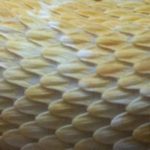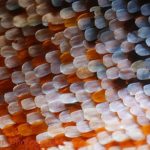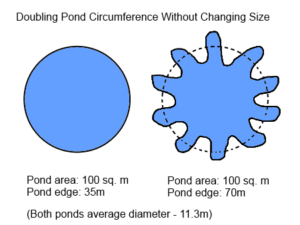Something here around criteria with hyperlinks to the pieces of assessment criteria…
 I attend the 13-day Permaculture design course delivered by the Brighton Permaculture Trust between 20 Feb 2016 and 12 Jun 2016. Below you will find my final portfolio which I have chosen to do online to serve as a lasting record for myself which is also easily accessible.  This medium has the added benefit that it will allow me to more easily share it – for instance, with my mother in America who has a burgeoning interest in Permaculture.
I attend the 13-day Permaculture design course delivered by the Brighton Permaculture Trust between 20 Feb 2016 and 12 Jun 2016. Below you will find my final portfolio which I have chosen to do online to serve as a lasting record for myself which is also easily accessible.  This medium has the added benefit that it will allow me to more easily share it – for instance, with my mother in America who has a burgeoning interest in Permaculture.
Anywhere you see a number in parenthesises after a word or phrase it is indicating an example of a permaculture principle in action.  The number is a reference to the corresponding numbered principle, below.

Where a word or phrase is followed by parentheses with a two letter code it is an example of the ethics in practice. Â The references are:
(EC) Â Earth Care
(PC) Â People Care
(FS) Â Fair Share
Our course overview:
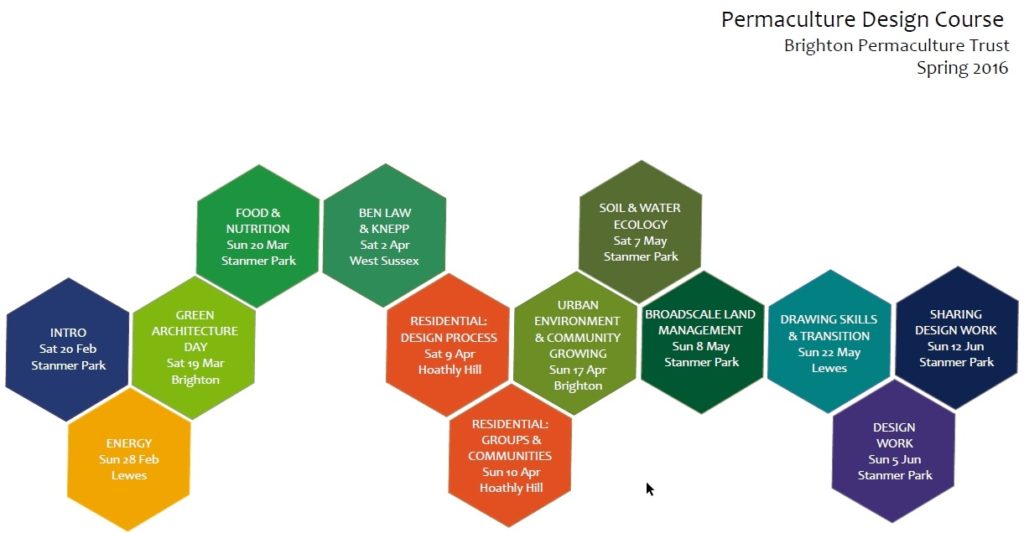
Linkwork 1 – Energy
For our first piece of linkwork we were asked to do some online surveys to quantify out energy use. Below you will find my completed assessments.



Whilst this activity was interesting, and led to significant discussion within the group, I didn’t feel it was very accurate. Most of us found that it was calculating figures based on the “average” person – which is understandable – but most of us were not using water/electricity in an “average” way. Â I think this is likely because anyone who is on a permaculture course already has a good awareness of energy efficiency and has already made steps to be more efficient. Â These nuances were not reflected in any of the surveys and as such none of us had results that were similar to our actual usage.
For instance, in my house we do have a power shower but only 1 of the 4 occupants uses it.  However, the survey assumes that if you have one it is being used by everyone and therefore our results were over-calculated.  Survey results vs. actual results below:
Water
Survey:  £548
Actual:  £405    (26.1% less than calculated)
Electricity
Survey: £1,720
Actual: £1,274  (25.9% less than calculated)
Conclusions & next actions
Despite my dissatisfaction with the surveys I was able to gain an incredible amount of insight and ideas from the day’s activities and identified my next actions as:
- Research closed-loop showers with water recycling
- Research and find a plumber to install toilet with dual valve to make use of our stored rain water
- Feedback information on keeping a healthy septic system to my parents
- Research Salt batteries
Linkwork 2 – Patterns in Nature
The field of research concerned with imitating nature is called biomimetics.
“Biomimicry is the conscious emulation of nature’s wisdom,” says Tim McGee, a senior biologist with the Biomimicry Institute, a nonprofit that brings together scientists, engineers, and architects to create sustainable technologies. “It’s looking to nature to understand the patterns of how it works, why it works.” (Dnigelis, 2011)
The two patterns I chose to focus on for this linkwork was tessellation tilings and fractals/branching.
1. Â Tessellation Tiling
I chose this pattern because I find it to be both beautiful and immensely practical. This pattern has two primary benefits;  protecting the structure whilst still allowing free movement.  It is characterised by overlapping repeating tiles, usually of a more-or-less exactly repeating units.
Examples in nature include:
Mankind has been able to utilise this natural pattern in ways ranging on both ends of Maslow’s scale: from keeping the rain off, to photographing memories and art.
Examples as used by man:
2. Â Fractals
Fractals are interesting as it is both a natural phenomenon and a mathematical set. Like the Koch snowflake this pattern allows for nearly infinite edge growth(11) whilst not increasing the area by a correlated amount. This allows maximum edge effect which encourages greater diversity and richer conditions for both domains. Examples in nature:
The single greatest way we can use the primary benefit of fractals is in maximising the edge effect. With successful design you can double the circumference of a pond or field without increasing the area.
This has been successfully used in staggered planting, keyhole beds and chinampa.
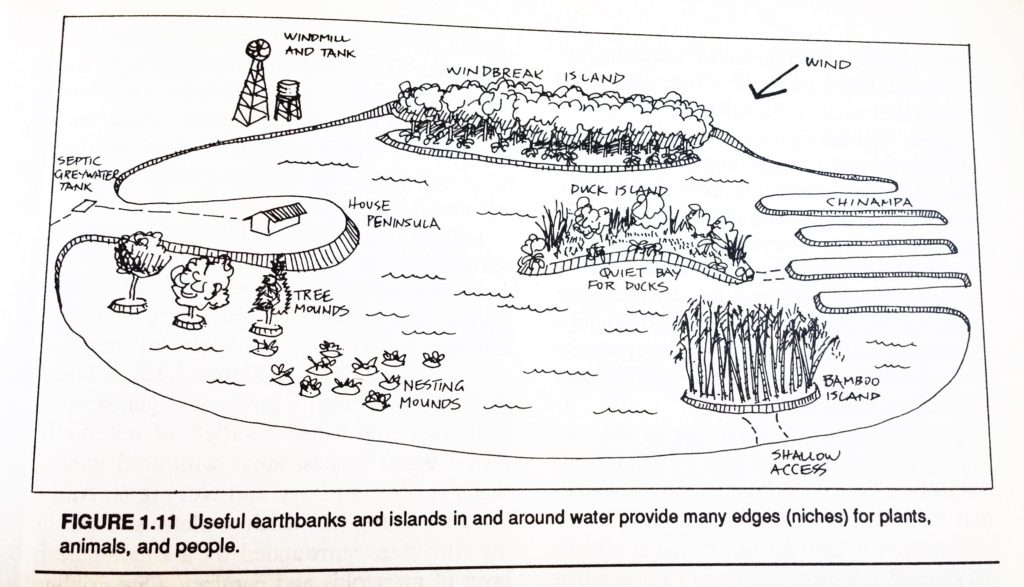
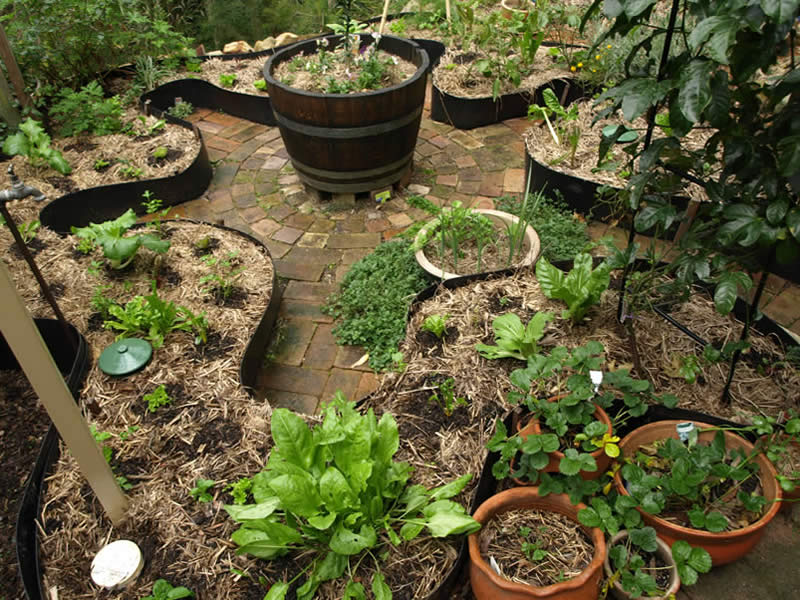
Conclusions & next actions
Nature knows what it’s doing.  I know for a permaculturalist this goes without saying as it’s the very foundation on which permaculture is based, but it bears repeating. Things have survived and thrived due to their specialised and fit-for-purpose designs and if we want our plans to thrive in the same way we must follow suit.
Things to focus on going forward:
- Incorporating more beneficial curves in my designs to increase edge
- Ensuring these curves are also practical and don’t hinder the user
- Better observe patterns in nature  (I found this piece of link work eye-opening and had not really grasped the concept of patterns before this.)
Linkwork 3Â -Â Human Patterns
For this linkwork we were asked,
“… If you were to design for your own health and well-being, think about what tools you would use in the SURVEY stage of the design cycle.”Â
This day of our learning journey was a particularly poignant one for me as I have a persistently nagging voice telling me I’m not taking care of myself in the way that I should. That little voice is aware of the reasons; working full time, raising two children, volunteering at my kids’ school, and taking on projects such as this course.  And while my inner-self knows how important those things are, it continues to persistently voice its concerns.
Unfortunately, that voice does not come with a clear instruction manual or map and so I needed to SADIMET myself.  😀
As with everything I started with a client interview and after doing so I found that my three greatest areas of concern are:
- Â My physical health, specifically around diet and exercise
- Â My emotional health, specifically around ‘burning out’ and not being able to fill my bucket
- Â My relationships, particularly with my children and husband, which is a direct result of #1 and #2 (PC)
(For the sake of this paper I’m only going to focus on physical health.)
In order to survey myself I used a variety of methods.
For physical health:
- Plot out my regular routine
- Complete a food diary  (see food plan, below)
- Get a full set of blood tests
- Measure height, weight, physical measurements, BMI, etc.
From there I analysed the data using the following methods:
- A nourishing/depleting analysis of my routine
- AÂ PMI of my diet focusing both on nutrition and ethical purchasing (EC, PC & FS!)Â (see food plan, below)
- Compared blood test results with ideal results and identify areas for improvement
- Used physical measurements to create a baseline (which, for the sake of my self-esteem, I will not be presenting here. Â Let’s just agree the answer was ‘fat’.)
Conclusions & next actions
I went on to “design” a series of actions to help improve identified areas for development. The primary changes were:
- sourcing my foods from more ethical suppliers (where I would value food miles over organic if I had to pick)
- reducing my meat and dairy consumption
- increasing my physical activity
- practising mindfulness & meditation
post script
As an aside, in an effort to survey my emotional health I took the National Accounts of Wellbeing survey from nef. Â Below are my results (green) compared to the UK (purple) and the EU average (grey).
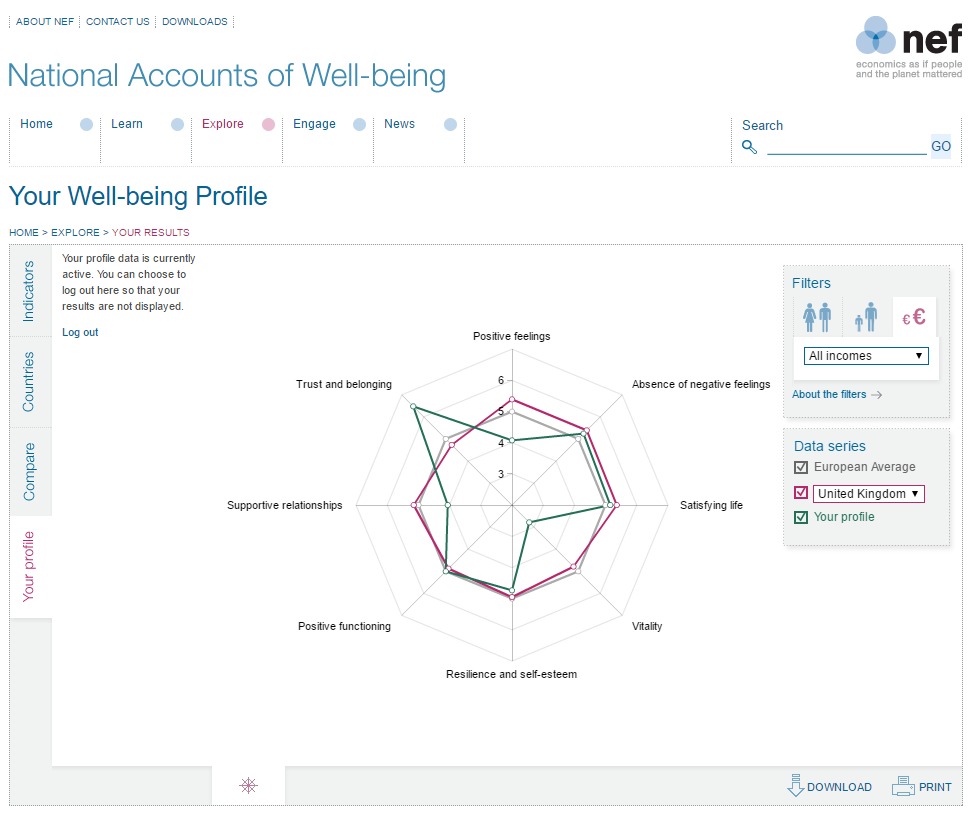
I then read their article on the five ways to well-being and have implemented a few of their suggestions such as becoming more active (exercise) and taking notice (meditation/mindfulness) which also tied into my physical improvements.
However, it occurs to me it might just be simpler to move to Denmark. Â Look how happy they are! (purple)
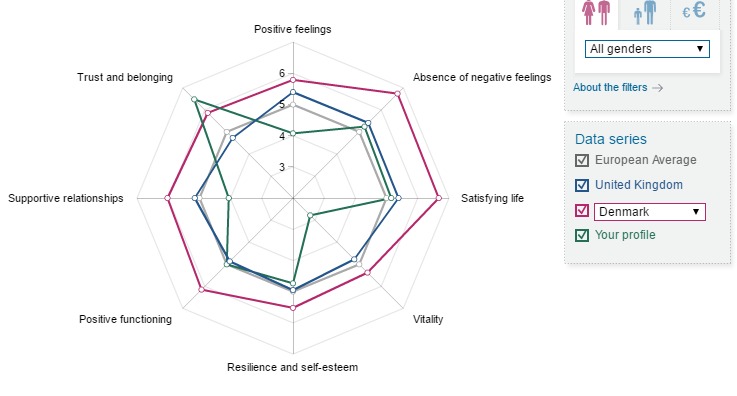
Linkwork 4 – Personal Food Design

We were asked to keep a food diary for at least three days charting various factors. Â You can see my diary to the right.
Non-nutritional evaluation of my food
It was recommended that we survey our food choices using the Growing Communities ‘Food Zones’ model. While this is a good model, it didn’t evaluate my food based on criteria that are in line with my personal values. Consequently, I created an alternative model which I’m going to coin the ‘Collington Food Choices model.’  (because I can.)Â
The basic equation is  organic x retailer type x distance item travelled based on the following points system:
| Points -> | 1 | 2 | 3 | 4 | 5 |
|---|---|---|---|---|---|
| organic | yes | no | GMO | ||
| retailer | self | small business | conglomerate | ||
| distance | on property | local area |  within 70 miles | national | international |
Examples:
- Eggs from my own flock of organic chickens = 1pt  (1 x 1 x 1)
- Potatoes (not organic) I bought from my local farm shop = 8pts  (2 x 2 x 2)
- Organic oranges (from Florida) bought from my village shop = 10pts  (1 x 2 x 5)
- GMO grapes from Spain bought at Sainsbury’s = 45pts  (3 x 3 x 5)
As you can see from my food diary I elected not to complete the “where from in the world” column because most of my meals are home-cooked so I needed to evaluate each ingredient. Therefore, during the eight days I kept my food journal I calculated a score for each ingredient item where I could identify the various factors. Â E.g., I didn’t calculate my food at Pizza Hut because I had no idea where they source their ingredients.
For instance, my very first meal looks like this:
- Potatoes from Sainsbury’s = 24pts  (2 x 3 x 4)
- Eggs from my own flock of organic chickens = 1pt  (1 x 1 x 1)
- Butter (Yeo Valley bought at Sainsbury’s) = 12pts  (1 x 3 x 4)
- Salt (Cornish Sea Salt Co. bought at Sainsbury’s) = 12pts  (1 x 3 x 4)
- Organic Coconut Oil bought at Costco = 15pts  (1 x 3 x 5)
- Tea bags from Sainsbury’s = 30pts  (2 x 3 x 5)
- Milk (Cravendale) from Sainsbury’s = 24pts  (2 x 3 x 4)
- Tap water = 1pt  (1 x 1 x 1)
- Total points (119) divited by total items (8) = 15pts
Sadly, this was a relatively “good” meal as the average for all of my calculatable items was:  27pts (boo)
My evaluation:
- organic – I’m doing ok
- retailer – really bad
- distance – neutral but could do better.
I identified my aim as: Â Evaluate and use my priorities to ensure more meaningful purchases. Â This includes accepting my limitations (and not being plagued by green guilt) and making the best choices under the circumstances.
To do this, I aligned my goals to three permaculture principles
- Obtain a Yield.
- Integrate rather than Segregate.
- Produce no Waste.
It goes without saying, but for the purpose of documentation: Â This is also aligned to the permaculture ethics:
- Earth Care – energy, chemicals
- People Care – chemicals, local business
- Fair Share – local economy, food waste
I researched and evaluated a number of different food sourcing options including: grow-my-own, vegetable box deliver, whole-recipe box delivery, local small retailers and online ethical retailers. Evaluation was based on the above principles, namely; What I can do for myself? What can fit in to my busy life with little modification? What will allow me to reduce my waste – both physical and financial?
- Garden more: Garden not large enough to be self sustaining. Need more annual beds including increasing perennials. Need to plant micro orchard/food forest. Need to improve growing skills (brown thumb – not something I find comes naturally).
- Recipe box delivery: I tried Able and Cole for veg boxes, and Gousto, Hello Fresh and Mindful Chef for recipe boxes. We wasted most of our Able and Cole boxes, not knowing what to do with the unusual veg. We had more luck with the recipe boxes but they were expensive.
- Local shops: We live in a small village with no local shop. The nearest farm shop is Middle Farm but that is an upscale shop with a price tag to match. I did find a website that evaluates how ethical the high-street grocery stores are – will focus on the highest-scoring companies. Need to see if I can source a local farmers market that runs at a time when I’m not at work nor have other child commitments.
- Online ethical retailers: I’m not sure this can be deemed an ethical choice due to the increased food miles required to get an item to your door. However, it has been invaluable in allowing me to source products I cannot find anywhere else (e.g. amla powder and hibiscus tea.)
Conclusion and next steps:
None of the above options provided a stand-alone answer. We will try to improve our growing expertise and improve the size of our garden. We will continue to get the recipe boxes on an occasional basis as a ‘treat’ and to help us learn some new recipes. Need to find a local farmers market and in the meantime focus on shopping at Co-op, M&S and Aldi. Looking to the long term we will plant our micro food forest.

